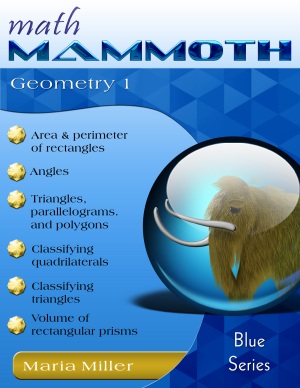Free geometry videos online
Enjoy free online math videos on these geometry topics, for abouth 4th-5th grade. I also maintain a more comprehensive page that lists all my geometry videos for grades 1-7. This page has geometry videos for grades 4-5. Choose a topic from below:
- Lines, rays, and angles
- How to use a protractor to measure & draw angles
- Estimating angles
- How to draw a right angle (perpendicular line) and a rectangle
- Parallelograms
- Acute, obtuse, and right triangles
- Circles
- Polygons—introduction
- Perimeter
- Area of rectangles
- Area versus perimeter
- Volume of a rectangular prism and cubic units
- Angle sum of a triangle -- 180 degrees
- Angles in a Parallelogram
- Vertical angles
You can use these videos...
- ...to learn these topics yourself (if you're a student for example, or an adult needing a refresher)
- ...as lesson plans for teaching these topics. Often, one video from below can be made into several lessons with students.
The videos on this page match the lessons in my book Math Mammoth Geometry 1 (Blue Series book), or the lessons in chapter 6 of Grade 4-B curriculum (Light Blue series). In either book, you will get MANY more practice exercises, word problems, and puzzles than what are shown in the videos, and also some lessons that are not in covered in this set of videos.
 113 pages (includes answers) PDF download $6.90 Printed copy $12.70 |
Math Mammoth Geometry 1 worktext
Free sample pages (PDF) |
Lines, rays, and angles
First I explain the difference between a line and a ray in geometry. Then, an angle is defined as two rays originating from the same point - called the vertex of the angle.I discuss the size of an angle, and how it does not depend on the sides of an angle. I show the imaginary arc of a circle that is drawn when an angle opens further and further. Lastly I go through a few exercises about which angle is bigger.
How to use a protractor to measure & draw angles
I explain what an angle measure is, how to measure angles with a protractor, and how to draw angles with a protractor.When an angle "opens", it draws an arc of a circle, and we compare that arc to the full circle, which is 360 degrees.
Using a protractor is fairly straight-forward. You line up one side of your angle with the protractor's "zero-line" and you place the midpoint of the protractor to the vertex of the angle. Then you read the angle measure where the other side of the angle touches the half-circle of the protractor. But you need to place the protractor right.
Estimating angles
Estimating angle measures is based on comparing them to some ballpark angles, such as the right angle, the 45° angle, and the 30° angle (which is the angle between two consecutive numbers on the clock face).First, I estimate a few angles. Then I draw a few angles by estimating them (not measuring), and check afterwards.
Lastly in this video I explain the concept of turning in a specific angle, such has turning in a 30° angle.
How to draw a right angle (perpendicular line) and a rectangle
I show how you can draw a right angle (or a perpendicular line to a given line) using either a protractor or a triangular ruler. I also show a line perpendicular to a given line, drawn through a point on the line, or drawn through a point not on the line.Lastly, I draw a rectangle with given side lengths, using a protractor to make right angles, and a regular ruler to measure the sides.
This lesson is meant for grade 3 or 4.
Parallelograms
What is a parallelogram? The definition says it's a figure enclosed by two sets of parallel lines, and that's where we will start. The DEFINITION does not say a thing about its side lengths or angle measures. Those things students can notice or find out for themselves by drawing and measuring.I also draw a bigger copy of a given rhombus, which is a very good drawing exercises for students, and give ideas for more drawing problems on a basic level.
Acute, obtuse, and right triangles
This lesson is a starting point for classifying triangles by their angles. A right triangle has one right angle. (What about the other two angles? We'll find out.) An obtuse triangle has one obtuse angle. (What about the other two angles? We'll find out.) An acute triangle has THREE acute angles.Circles
What is a circle? It is a figure where the distance from the center point to any point on the outer line (circumference) is the same. So, that is why an oval won't classify as a circle.Students need to practice drawing circles of various sizes using a compass. Drawing concentric circles is a fun exercise for them.
I show two other drawing exercises: to draw a circle inside a square and then to copy a simple circle design.
Polygons - introduction
This is an introduction to polygons for elementary school - approximately 4th grade.I like to give students the exercises of drawing randomly 4, 5, 6, 7, or 8 points on the paper and connecting them to get a polygon.
I also show exercises where we divide polygons into new ones, or put together polygons to get new ones.
Perimeter - the concept and varying exercises
The concept of perimeter is simple: it's like going around a figure, and checking what distance you went. We find perimeter by adding the side lengths. The difficulty comes in remembering what the word means. I solve several different problems involving perimeter, including ones where the perimeter is given and side lengths are asked. This lesson is meant for grade 4 onwards.Area of rectangles - varied problems
I work through varied problems that involve the area of rectangles -- feel free to use them with your students in your geometry class. Suitable for grades 3-5.Area versus Perimeter
We take a look at geometry problems that involve both area and perimeter of rectangles. For example, the area of a square is given, and perimeter is asked. Or, vice versa: the perimeter of a square is given and the area is asked. Then I solve two problems where some side lengths and other info is given, and either perimeter or area is asked. Lastly we look at this open-ended problem: If the area of a rectangle is 18 square centimeters, what can its perimeter be?Volume of a rectangular prism and cubic units
Volume is measured in cubic units, or "little cubes". If the sides of your "little cube" are 1 cm, then it is 1 cubic centimeter. Similarly, if the sides of your "little cube" are 1 in., then it is 1 cubic inch.I demonstrate with baby blocks how to find the volume of rectangular prisms. Then we solve some word problems involving volume of rectangular prisms (boxes).
The following videos are older, and are not HD. The last one does not belong with the book Math Mammoth Geometry 1.
Angle sum of a triangle -- 180 degrees - Video
An easy proof that angle sum of a triangle is 180 degrees, accessible to middle school students and even younger. (This topic is meant for middle school students.)Angles in a Parallelogram
Starting from two parallel lines and a line intersecting them both, I show that the opposite angles in a parallelogram are equal, and that the angle sum is 360 degrees. (This topic is meant for middle school, about grade 7.)Vertical Angles - a proof on video
Showing a short and easy proof why vertical angles are equal. (This topic is meant for middle school, about grade 7.)Most of the videos on this page match the lessons in my book Math Mammoth Geometry 1 (Blue Series book), or the lessons in the geometry chapters of Grade 4 and Grade 5 of Light Blue series. In the books, you will get many more practice exercises, word problems, and puzzles than what are shown in the videos, and also some lessons that are not in covered in this set of videos.
 113 pages (includes answers) PDF download $6.90 Printed copy $12.70 |
Math Mammoth Geometry 1 worktext
Free sample pages (PDF) |
By Maria Miller
Receive my monthly collection of math tips & resources directly in your inbox — and get a FREE Math Mammoth book!
You can unsubscribe at any time.
